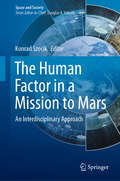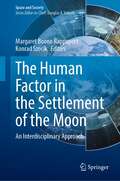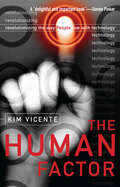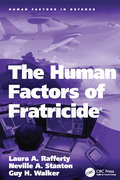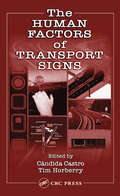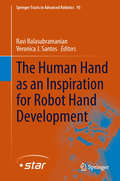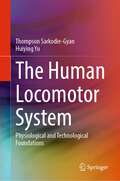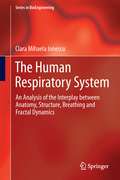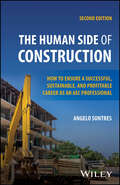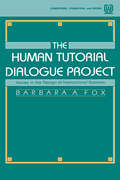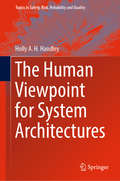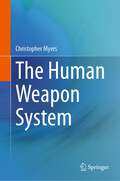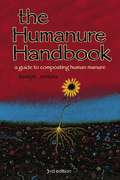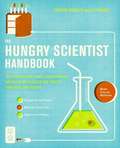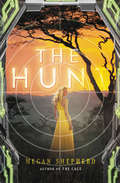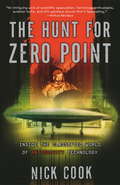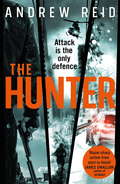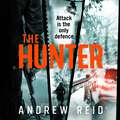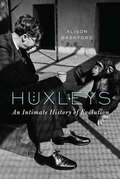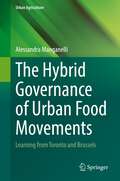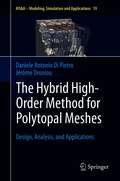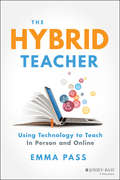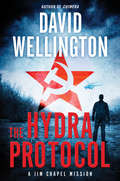- Table View
- List View
The Human Factor in a Mission to Mars: An Interdisciplinary Approach (Space and Society)
by Konrad SzocikA manned mission to Mars is faced with challenges and topics that may not be obvious but of great importance and challenging for such a mission. This is the first book that collects contributions from scholars in various fields, from astronomy and medicine, to theology and philosophy, addressing such topics. The discussion goes beyond medical and technological challenges of such a deep-space mission. The focus is on human nature, human emotions and biases in such a new environment.The primary audience for this book are all researchers interested in the human factor in a space mission including philosophers, social scientists, astronomers, and others. This volume will also be of high interest for a much wider audience like the non-academic world, or for students.
The Human Factor in the Settlement of the Moon: An Interdisciplinary Approach (Space and Society)
by Konrad Szocik Margaret Boone RappaportApproaching the settlement of our Moon from a practical perspective, this book is well suited for space program planners. It addresses a variety of human factor topics involved in colonizing Earth's Moon, including: history, philosophy, science, engineering, agriculture, medicine, politics & policy, sociology, and anthropology. Each chapter identifies the complex, interdisciplinary issues of the human factor that arise in the early phases of settlement on the Moon. Besides practical issues, there is some emphasis placed on preserving, protecting, and experiencing the lunar environment across a broad range of occupations, from scientists to soldiers and engineers to construction workers. The book identifies utilitarian and visionary factors that shape human lives on the Moon. It offers recommendations for program planners in the government and commercial sectors and serves as a helpful resource for academic researchers. Together, the coauthors ask and attempt to answer: “How will lunar society be different?”
The Human Factor: Revolutionizing the Way People Live with Technology
by Kim J. VicenteIn this incessantly readable, groundbreaking work, Vincente makes vividly clear how we can bridge the widening gap between people and technology. He investigates every level of human activity - from simple matters such as our hand-eye coordination to complex human systems such as government regulatory agencies, and why businesses would benefit from making consumer goods easier to use. He shows us why we all have a vital stake in reforming the aviation industry, the health industry, and the way we live day-to-day with technology.
The Human Factors of Fratricide (Human Factors in Defence)
by Neville A. Stanton Laura A. RaffertyFratricide has been defined as firing on your own forces, when mistaking them for enemy forces, which results in injury or death. Rates of fratricide incidence have been steadily increasing and the complexity of the contemporary operating environment may lead to a continuation of this trend. Although the majority of research into fratricide has focused on the development of technological decision aids, recent explorations highlight the need to emphasise the social aspects within a socio-technical framework. This book presents and validates, via the use of case studies, a model of teamwork and decision-making factors that are associated with incidents of fratricide. In summary, it offers a review and evaluation of contemporary theoretical perspectives on teamwork and fratricide, as well as a range of accident analysis approaches. A novel theory of fratricide is then presented followed by a new methodology for assessing fratricide. Naturalistic case studies of teams are undertaken in the military domain. These studies illustrate the approach and offer early validation evidence. In closing, the book presents a series of principles designed to reduce the likelihood of fratricide in the future.
The Human Factors of Transport Signs
by Tim Horberry Cándida CastroThe ubiquitous nature of transport signs on roadways, railways, and in airports can lead to an overload of visual information, yet little research has been done to understand the design and use of such signs from a driver‘s perspective. The Human Factors of Transport Signs explores key transport sign research and examines new technologies that are revolutionizing signaling. While concentrating largely on the road environment and general signing issues, the authors also address specific railway and other transport modality topics. International contributors discuss driver psychology and interaction with transport signs as well as the strengths and weaknesses of different types of signs.
The Human Hand as an Inspiration for Robot Hand Development
by Ravi Balasubramanian Veronica J. Santos"The Human Hand as an Inspiration for Robot Hand Development" presents an edited collection of authoritative contributions in the area of robot hands. The results described in the volume are expected to lead to more robust, dependable, and inexpensive distributed systems such as those endowed with complex and advanced sensing, actuation, computation, and communication capabilities. The twenty-four chapters discuss the field of robotic grasping and manipulation viewed in light of the human hand's capabilities and push the state-of-the-art in robot hand design and control. Topics discussed include human hand biomechanics, neural control, sensory feedback and perception, and robotic grasp and manipulation. This book will be useful for researchers from diverse areas such as robotics, biomechanics, neuroscience, and anthropologists.
The Human Locomotor System: Physiological and Technological Foundations
by Thompson Sarkodie-Gyan Huiying YuThe textbook describes the complexity of the human dynamic behavior in space and its ability to produce coordinated, adaptive, dynamically stable movements under steady conditions while negotiating complex terrains and experiencing unexpected perturbations. Applying fundamental theories of biomechanics and physiology, the authors further consider the physical, perceptual, and motor aspects of the locomotor system towards the analysis of how humans can behave adaptively in space by virtue of their intelligent sensory-motor functions and to illuminate our understanding of how this complexity in behavior can provide insight into the neural control of locomotion of the musculoskeletal system. The text provides a foundation for describing the normal and abnormal human locomotor systems. The Human Locomotor System: Physiological and Technological Foundations is intended as a primary text for upper-undergraduate and graduate-level courses in neuroscience, gait analysis, kinesiology, physical therapy, sports science, and biomedical and rehabilitation engineering. It is also a valuable professional reference for scientists and engineers at medical and pharmaceutical companies involved in bioengineering research and development.
The Human Respiratory System: An Analysis of the Interplay between Anatomical Structure and Breathing Dynamics
by Clara Mihaela IonescuThe Human Respiratory System combines emerging ideas from biology and mathematics to show the reader how to produce models for the development of biomedical engineering applications associated with the lungs and airways. Mathematically mature but in its infancy as far as engineering uses are concerned, fractional calculus is the basis of the methods chosen for system analysis and modelling. This reflects two decades' worth of conceptual development which is now suitable for bringing to bear in biomedical engineering. The text reveals the latest trends in modelling and identification of human respiratory parameters with a view to developing diagnosis and monitoring technologies. Of special interest is the notion of fractal structure which is indicative of the large-scale biological efficiency of the pulmonary system. The related idea of fractal dimension represents the adaptations in fractal structure caused by environmental factors, notably including disease. These basics are linked to model the dynamical patterns of breathing as a whole. The ideas presented in the book are validated using real data generated from healthy subjects and respiratory patients and rest on non-invasive measurement methods. The Human Respiratory System will be of interest to applied mathematicians studying the modelling of biological systems, to clinicians with interests outside the traditional borders of medicine, and to engineers working with technologies of either direct medical significance or for mitigating changes in the respiratory system caused by, for example, high-altitude or deep-sea environments.
The Human Side of Construction: How to Ensure a Successful, Sustainable, and Profitable Career as an AEC Professional
by Angelo SuntresAn incisive guide to navigating the construction industry and dealing with the people who work in it In the newly revised second edition of The Human Side of Construction: How to Ensure a Successful, Sustainable, and Profitable Career as an AEC Professional, renowned construction professional Angelo Suntres delivers an insightful discussion of the root cause of many of the issues plaguing the construction industry today—the lack of human connection. Suntres explains that, in an industry undergoing dramatic changes driven by technology, innovation, and new ways of working, construction professionals will need to make a fundamental shift in the way they think and operate. The book walks you through how to connect and collaborate with others in the industry and how to address the most common challenges you’ll face every day in construction. You’ll find: A thorough introduction to relationship building and effective communication with construction industry personnelComprehensive explorations of what the construction industry is really like, including real-world examples and techniques to advance your careerPractical discussions of how to find a job that you’ll thrive in and how to stand out from the crowdIn-depth treatments of sustainability, diversity, equity, and inclusion in the construction industry Perfect for construction industry professionals, including project managers, contractors, and engineers, The Human Side of Construction will also benefit property owners and managers who regularly deal with people involved in construction.
The Human Tutorial Dialogue Project: Issues in the Design of instructional Systems
by Barbara A. FoxThis volume's goal is to begin to document the dialogue processes in naturally-occurring human tutoring, in the context of informing the design of intelligent tutoring systems, and of interactive systems in general. This project represents the first empirical study of human tutorial dialogue from a conversation analytic perspective -- the conversational interaction is the focus of analysis rather than larger scale techniques for teaching. It is also the first study of tutoring to make use of large quantities of carefully transcribed tutoring conversations/dialogues. The motivation for this focus comes from two sources: First, although all tutoring systems have implicit theory or theories of minute-level interaction built into them, little research has been done to form an empirical foundation for such theories. Therefore, current systems tend to be based on the designers' intuitions rather than on data. This fact almost certainly makes systems unnecessarily brittle in actual use. Second, of the small but growing collection of empirical studies of tutoring, almost all have been designed and carried out by computer scientists, whose training naturally leads them to be concerned with interaction at the level of knowledge transfer and teaching techniques. Fox's training as a linguist brings attention to the minute-by-minute details of the interaction, in particular to the processes that bring the interaction into existence and allow it to develop relatively smoothly.
The Human Viewpoint for System Architectures (Topics in Safety, Risk, Reliability and Quality #35)
by Holly A.H. HandleyThis book describes a methodology to represent socio-technical system concerns in the system architecting process. The resulting set of Human Views augments traditional system viewpoints with human-focused data. The Human Viewpoint methodology classifies the socio-technical system context, identifies and collects pertinent data, renders models that can be used for discussion and analysis, and presents the results in Fit for Purpose views that are useful for decision making. The inclusion of the Human Viewpoint during the system architecting stage allows the evaluation of human-system design trade-offs, recognises the impact of the human operator on system performance, and provides the foundation for Human System Integration evaluations during the ensuing system development.
The Human Weapon System
by Christopher MyersThis book discusses the differences between a human weapon system and a tactical athlete and what a human optimization program is. Furthermore, this book discusses and demonstrates how to put together a training program at an organizational level for the human weapon system. A systematic approach is presented and discussed, from initial analysis of the human weapon system to creating a multi-domain human performance optimization program. This book strives to familiarize the reader with the systematic approach that the author has utilized as an exercise physiologist in the Department of Defence over the past ten years. This book also explains how to utilize technology to individualize the human performance optimization program at an organizational level. The book discusses current technologies in power generation, measuring endurance, and nutrition, and also demonstrates to strength coaches and practitioners how to use these technologies and individualize optimization.
The Humanure Handbook: A Guide to Composting Human Manure (Third Edition)
by Joseph JenkinsThis well researched handbook brings experts with over two decades of experience on the topic of composting human manure available anywhere. It reviews the various issues pertaining to human waste including potential health risks and how to eliminate those dangers in order to safely convert humanure into garden soil.
The Hungry Scientist Handbook
by Patrick Buckley Lily BinnsInventive, (mostly) edible DIY gadgets and projects guaranteed to captivate The Hungry Scientist Handbook brings DIY technology into the kitchen and onto the plate. It compiles the most mouthwatering projects created by mechanical engineer Patrick Buckley and his band of intrepid techie friends, whose collaboration on contraptions started at a memorable 2005 Bay Area dinner party and resulted in the formation of the Hungry Scientist Society--a loose confederation of creative minds dedicated to the pursuit of projects possessing varying degrees of whimsy and utility. Featuring twenty projects ranging from edible origami to glowing lollipops, cryogenic martinis to Tupperware boom boxes, the book draws from the expertise of programmers, professors, and garden-variety geeks and offers something to delight DIYers of all skill levels.
The Hunt (Cage #2)
by Megan ShepherdThe Maze Runner meets Scott Westerfeld in the second novel in this gripping and romantic YA series about teens abducted from Earth by an otherworldly race--from Megan Shepherd, the acclaimed author of the Madman's Daughter series.They've left the cage--but they're not free yet.After their failed escape attempt, Cora, Lucky, and Mali have been demoted to the lowest level of human captives and placed in a safari-themed environment called the Hunt, along with wild animals and other human outcasts. They must serve new Kindred masters--Cora as a lounge singer, Lucky as an animal wrangler, and Mali as a safari guide--and follow new rules or face dangerous consequences. Meanwhile, Nok and Rolf have been moved into an enormous dollhouse, observed around the clock by Kindred scientists interested in Nok's pregnancy. And Leon, the only one who successfully escaped, has teamed up with villainous Mosca black-market traders.The former inhabitants of the Cage are threatened on all fronts--and maybe worst of all, one of the Hunt's Kindred safari guests begins to play a twisted game of cat and mouse with Cora. Separated and constantly under watch, she and the others must struggle to stay alive, never mind find a way back to each other. When Cassian secretly offers to train Cora to develop her psychic abilities--to prove the worthiness of humanity in a series of tests called the Gauntlet--she'll have to decide fast if she dares to trust the Kindred who betrayed her, or if she can forge her own way to freedom.
The Hunt for Zero Point: One Man's Journey To Discover The Biggest Secret Since The Invention Of The Atom Bomb
by Nick CookThis riveting work of investigative reporting and history exposes classified government projects to build gravity-defying aircraft--which have an uncanny resemblance to flying saucers. The atomic bomb was not the only project to occupy government scientists in the 1940s. Antigravity technology, originally spearheaded by scientists in Nazi Germany, was another high priority, one that still may be in effect today. Now for the first time, a reporter with an unprecedented access to key sources in the intelligence and military communities reveals suppressed evidence that tells the story of a quest for a discovery that could prove as powerful as the A-bomb. The Hunt for Zero Point explores the scientific speculation that a "zero point" of gravity exists in the universe and can be replicated here on Earth. The pressure to be the first nation to harness gravity is immense, as it means having the ability to build military planes of unlimited speed and range, along with the most deadly weaponry the world has ever seen. The ideal shape for a gravity-defying vehicle happens to be a perfect disk, making antigravity tests a possible explanation for the numerous UFO sightings of the past 50 years. Chronicling the origins of antigravity research in the world's most advanced research facility, which was operated by the Third Reich during World War II, The Hunt for Zero Point traces U. S. involvement in the project, beginning with the recruitment of former Nazi scientists after the war. Drawn from interviews with those involved with the research and who visited labs in Europe and the United States, The Hunt for Zero Point journeys to the heart of the twentieth century's most puzzling unexplained phenomena. From the Hardcover edition.
The Hunter: the gripping thriller that should 'should give Lee Child a few sleepless nights'
by Andrew ReidSOMETIMES, ATTACK IS THE ONLY DEFENCE.'Razor-sharp action from start to finish.' JAMES SWALLOW'Top drawer...should give Lee Child and Simon Kernick a few sleepless nights.' JAMES OSWALDA troubled genius who vanishes in a mysterious car crash.A disillusioned cop sensing conspiracy in the corridors of power.A ruthless team of mercenaries operating in the shadows.A billion-dollar business that wants the world in its grip.One link connects them all.A champion fighter. Betrayed and searching for the truth.CAMERON KING IS THE HUNTER.An action-packed thriller with the gripping twists of Terry Hayes' I AM PILGRIM and Gregg Hurwitz's ORPHAN X - and a lead as deadly as JACK REACHER and JASON BOURNE. Perfect for fans of Mark Dawson, David Baldacci, Stephen Leather, Tom Wood and Rob Sinclair.'An exhilarating, action-packed, gripping tale...a real page turner that thrills and entertains from start to finish.' ADAM HAMDYWHY READERS ARE RAVING ABOUT THIS PAGE-TURNING THRILLER:'I loved The Hunter and read it in one sitting...fast paced action tempered with intelligent plotting' LizLovesBooks'I am a massive fan of Jack Reacher and James Ryker so if you like those you are going to love this. It is fast paced and action packed' *****Goodreads reviewer'Big and bold conspiracy thriller...highly recommended' *****Goodreads reviewer'Had to complete this in 24 hours' *****Goodreads reviewer'A terrific page turner of a thriller...the ending is knock-out brilliant! Wonderfully cinematic, "The Hunter" would make a cracking film or TV series'. *****Goodreads reviewer'I rather hope someone will pick this up to turn it into a movie...it deserves it' *****Goodreads reviewer
The Hunter: the gripping thriller that should 'should give Lee Child a few sleepless nights'
by Andrew ReidATTACK IS THE ONLY DEFENCE.A troubled genius who vanishes in a mysterious car crash.A disillusioned cop sensing conspiracy in the corridors of power.A ruthless team of mercenaries operating in the shadows.A billion-dollar business that wants the world in its grip.One link connects them all.A champion fighter. Betrayed and searching for the truth.CAMERON KING IS THE HUNTER.An action-packed thriller with the gripping twists of Terry Hayes' I AM PILGRIM and Gregg Hurwitz's ORPHAN X - and a lead as deadly as JACK REACHER. Perfect for fans of Mark Dawson, David Baldacci, Stephen Leather, Tom Wood and Rob Sinclair.(P)2018 Headline Publishing Group Ltd
The Huxleys: An Intimate History of Evolution
by Alison BashfordA New Yorker and Economist Best Book of the Year Two hundred years of modern science and culture told through one family history. This momentous biography tells the story of the Huxleys: the Victorian natural historian T. H. Huxley (“Darwin’s Bulldog”) and his grandson, the scientist, conservationist, and zoologist Julian Huxley. Between them, they communicated to the world the great modern story of the theory of evolution by natural selection. In The Huxleys, celebrated historian Alison Bashford writes seamlessly about these omnivorous intellects together, almost as if they were a single man whose long, vital life bookended the colossal shifts in world history from the age of sail to the Space Age, and from colonial wars to world wars to the cold war. The Huxleys’ specialty was evolution in all its forms—at the grandest level of species, deep time, the Earth, and at the most personal and intimate. They illuminated the problems and wonders of the modern world and they fundamentally shaped how we see ourselves, as individuals and as a species. But perhaps their greatest subject was themselves. Bashford’s engaging, brilliantly ambitious book interweaves the Huxleys’ momentous public achievements with their private triumphs and tragedies. The result is the history of a family, but also a history of humanity grappling with its place in nature. This book shows how much we owe—for better or worse—to the unceasing curiosity, self-absorption, and enthusiasm of a small, strange group of men and women.
The Hybrid Governance of Urban Food Movements: Learning from Toronto and Brussels (Urban Agriculture)
by Alessandra ManganelliUndertaking a journey into the “hybrid governance” of urban food movements, this book offers an original and nuanced analysis of the urban milieu as epicentre of food activism and food governance. Through examples of food movements in the city-regions of Toronto and Brussels, the author highlights the critical governance tensions urban food initiatives experience as they develop in diverse ways and seek to change food systems and their related socio-political conditions. The author investigates urban food movements as they negotiate access to land in urban areas, build resilient food network organisations, and develop supportive policies and empowering institutions for urban food governance. Through the analysis of these tensions, the book effectively puts real-life challenges of urban food movements in the spotlight—challenges that are increasingly visible and pertinent in today’s converging climate, socio-political, and health crises. The author offers suggestions to improve alternative food practices and, ultimately, to design promising pathways to instigate food system change.
The Hybrid High-Order Method for Polytopal Meshes: Design, Analysis, and Applications (MS&A #19)
by Jérôme Droniou Daniele Antonio Di PietroThis monograph provides an introduction to the design and analysis of Hybrid High-Order methods for diffusive problems, along with a panel of applications to advanced models in computational mechanics. Hybrid High-Order methods are new-generation numerical methods for partial differential equations with features that set them apart from traditional ones. These include: the support of polytopal meshes, including non-star-shaped elements and hanging nodes; the possibility of having arbitrary approximation orders in any space dimension; an enhanced compliance with the physics; and a reduced computational cost thanks to compact stencil and static condensation. The first part of the monograph lays the foundations of the method, considering linear scalar second-order models, including scalar diffusion – possibly heterogeneous and anisotropic – and diffusion-advection-reaction. The second part addresses applications to more complex models from the engineering sciences: non-linear Leray-Lions problems, elasticity, and incompressible fluid flows. This book is primarily intended for graduate students and researchers in applied mathematics and numerical analysis, who will find here valuable analysis tools of general scope.
The Hybrid Teacher: Using Technology to Teach In Person and Online
by Emma PassA practical, educational technology resource for educators teaching remotely or in the classroom The most effective hybrid teachers are those that have a vast knowledge of instructional strategies, technologies, tools, and resources, and can masterfully build meaningful relationships with students in-person and through a screen. The Hybrid Teacher: Using Technology to Teach In-Person and Online will teach educators to leverage the technology they have access to both in their traditional brick-and-mortar classrooms and in remote learning environments, including established online and hybrid schools; emergency response models for pandemics, natural disasters; rural education; and connecting with students who can’t make it to school. Many of us had to adapt to online teaching during the COVID-19 pandemic, but we still need resources for optimizing our instruction and becoming the best teachers we can be. This book is a practical guide for teachers who want to prepare for current and future remote instruction or leverage the best practices of remote instruction and EdTech tools to bring back to their brick-and-mortar classrooms. Inside, you’ll learn about the impact of social and economic differences on classroom technology, and you’ll find strategies and advice for maximizing success in each situation. Learn how best to leverage technology in traditional brick-and-mortar and remote classrooms, with case studies of the hybrid school model Gain tips and techniques to ensure that your teachers, students, and parents have the skills to succeed with technology Discover strategies for setting norms and expectations and transitioning between online and traditional learning Put into place proven methods for accountability and assessment of classroom successes Gain resources to the most effective educational technologies available today in multiple subject areas including English language arts, science, math, social studies, visual arts, dance, drama, music, and general education View sample lesson plans for how to implement tools into your classroom, build culture and community, and adapt for different learners Given the current push to remote teaching during the pandemic and the uncertainty over what the return to school and the traditional brick-and-mortar classroom will look like, The Hybrid Teacher will be an invaluable resource on the shelves of teachers and administrators alike.
The Hydra Protocol
by David WellingtonTo prevent nuclear annihilation, wounded Special Forces operative Jim Chapel must infiltrate a top secret Russian military base and disable an unstable supercomputerA routine mission in Cuban waters to retrieve a hidden key code from a sunken Soviet submarine quickly changes course when Cuban officials are tipped off. It turns out that Nadia, the beautiful stranger who saves Chapel from being discovered, is actually a Russian agent, and her intel is shocking. Hidden during the Cold War, a forgotten Russian supercomputer controls hundreds of nuclear missiles, all aimed at the United States. Just one fail-safe error and America will be obliterated. And there have been glitches in the computer's programming. . . .To disarm Hydra before it plunges the United States into nuclear winter, Nadia and Chapel must travel across Eastern Europe and infiltrate a secret base hidden deep in the steppes of Central Asia. But as these uneasy allies discover, not everyone wants the weapon out of commission.Jim Chapel is out of his depth, and out of his element, but not out of the game.
The Hydra Protocol
by David WellingtonTo prevent nuclear annihilation, wounded Special Forces operative Jim Chapel must infiltrate a top secret Russian military base and disable an unstable supercomputerA routine mission in Cuban waters to retrieve a hidden key code from a sunken Soviet submarine quickly changes course when Cuban officials are tipped off. It turns out that Nadia, the beautiful stranger who saves Chapel from being discovered, is actually a Russian agent, and her intel is shocking. Hidden during the Cold War, a forgotten Russian supercomputer controls hundreds of nuclear missiles, all aimed at the United States. Just one fail-safe error and America will be obliterated. And there have been glitches in the computer's programming. . . .To disarm Hydra before it plunges the United States into nuclear winter, Nadia and Chapel must travel across Eastern Europe and infiltrate a secret base hidden deep in the steppes of Central Asia. But as these uneasy allies discover, not everyone wants the weapon out of commission.Jim Chapel is out of his depth, and out of his element, but not out of the game.
The Hydra Protocol
by David WellingtonTo prevent nuclear annihilation, wounded Special Forces operative Jim Chapel must infiltrate a top secret Russian military base and disable an unstable supercomputerA routine mission in Cuban waters to retrieve a hidden key code from a sunken Soviet submarine quickly changes course when Cuban officials are tipped off. It turns out that Nadia, the beautiful stranger who saves Chapel from being discovered, is actually a Russian agent, and her intel is shocking. Hidden during the Cold War, a forgotten Russian supercomputer controls hundreds of nuclear missiles, all aimed at the United States. Just one fail-safe error and America will be obliterated. And there have been glitches in the computer's programming. . . .To disarm Hydra before it plunges the United States into nuclear winter, Nadia and Chapel must travel across Eastern Europe and infiltrate a secret base hidden deep in the steppes of Central Asia. But as these uneasy allies discover, not everyone wants the weapon out of commission.Jim Chapel is out of his depth, and out of his element, but not out of the game.
